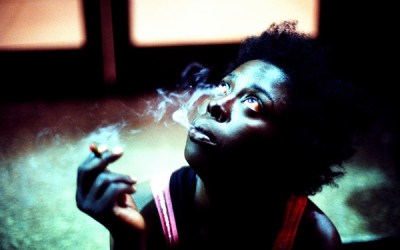“Up to Lexington, 125 / Feel sick and dirty, more dead than alive.” Lou Reed’s words I’m Waiting For the Man by The Velvet Underground are how many will have been introduced to the notorious corner joining 125th and Lexington Ave. Where that song told of an outsider’s trip to Harlem to buy drugs, Khalik Allah’s innovative new documentary, Field Niggas (2015) tries to give a voice to those whose lives are spent on that corner. It’s a hallucinatory photo-journalistic katabasis into the harsh, nocturnal world of the disenfranchised.
The provocative title is both artistic statement and fiery suggestion of modern-day slavery. The term ‘field negro’ comes from a famous speech by Malcolm X in which he strikingly highlighted the divisions within the black community – comparing the ‘field negro’ to the ‘house negro’. His point, and by extension Allah’s, is that while this segregation is no longer so blatant, it is no less problematic. In equating the homeless and drug-addicted denizens of this specific locale as a representative analogue to those forced labourers breaking their backs, Allah provides a stinging indictment of how the poor and forgotten – many of them African-American – are left to rot on New York’s unforgiving streets. “These streets is rough, yo; I don’t see nothing positive.” The abrasiveness of the title also serves to indicate the filmmaker’s refusal to submit to the conventions of his medium.
A photographer by trade, Allah has spent three years with these people, gaining their confidence enough to then move on to filming them and recording their words. Image and audio are dislocated, though. The pictures capture their subjects in a noirish contrast, often coloured by strip-lighting, moving in slow motion. They’re accompanied by unattributed dialogues, sometimes including the director himself, in which people talk about their lives, blighted by vagrancy, alcoholism, or addiction to the synthetic marijuana, K2. The images sometimes seem to correspond to the person speaking, at other times they appear to visualise concepts being referred to. This is cinematic poetry that forces the viewer not just to pay attention, but to engage completely with the work – discovering their own connections and narratives with eye and ear.
One such link might be the work of Pedro Costa, whose filmic odyssey into the world of the immigrant slum Fountainhas in Lisbon shows an equal regard for chiaroscuro imagery and the plight of the deprived. However, Allah is created something far more intimate. His camera hovers near faces, staring deep into bleary and haggard eyes that reflect all of the injustices that people describe – maltreatment comes from their fellow subjects as well as the police, who one voice describes as “upset ’cause they can’t find nobody to bully but homeless.” Perhaps surprisingly, Allah chooses to ignore the macro-issues, the sociopolitical injustices. Instead, he keeps his camera and microphone trained close on the resilient life in this little square of New York; the result is formally bracing, angrily urgent and deeply humane.
CPH:DOX runs from 5-15 November in Copenhagen. For more of our coverage, follow this link.



